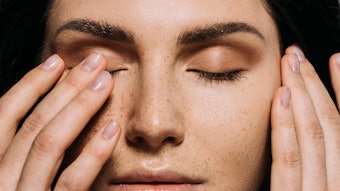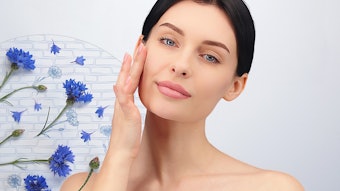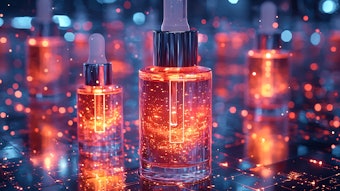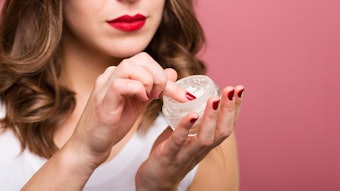
Hyperpigmented and post-inflammatory spots, melasma and freckles are visible, undesired skin imperfections that affect the perception of a young, healthy complexion. There are two main reasons for the formation of hyperpigmented spots. One is the sun—or to be more precise, over-exposure to the sun; the second is progressive aging and age-related inflammation.
The worst skin damage is not at the superficial epidermis level, but at a deeper level in the structure of the dermis. UV radiation damages the cell reproduction mechanism, modifying the distribution of melanin in the cutaneous tissue into localized, irregular, agglomerated clusters. This damage accumulates slowly but progressively, and becomes visible on the skin after years of photo-exposure.
In addition, aging increases the accumulation of lipofuscin granules. These yellow-brown pigments are composed mainly of lipid content, as well as sugars, proteins and metals. Their accumulation can be symptomatic of both membrane mitochondria and lysosome damage.
To address hyperpigmentation, skin lightening has become popular, especially in many Asian countries; although different skin types contain varying levels of the two types of melanin, pheomelanin and eumelanin. Caucasian skin is comprised mainly of pheomelanin, the yellow-red melanin, whereas Asian and African skin contain more eumelanin, the brown-black melanin. The shape and dimension of melanin granules in melanosomes also provide important contributions to the perceived color. Taking these considerations together, the formulation strategy for addressing pigmented spots must be multifunctional, as is described here.
Formulation
First and foremost, broad-spectrum UVA and UVB photoprotection is needed to inhibit further pigmentation and inflammation. Second, skin lighteners should be used that deeply penetrate the skin layers to reach where cell proliferation takes place. Other components include actives and exfoliants to stimulate skin renewal and shed pigmented sites more quickly; heavy metal-sequestering agents, to reduce the pigmenting effect of metallic ion complexes; antioxidants and free-radical quenchers, for a redox effect; and melanin production and transfer inhibitors, to slow the process of skin cell pigmentation. These effects must be incorporated into an easy-to-use formula that is aesthetically pleasing, stable and capable of allowing deep penetration of the active principles while keeping the sunscreen active on the skin. Therefore, skin-illuminating pigments, rheology modifiers and penetration enhancers are also added to spot-lightening formulations.
An example spot lightener is provided in Formula 1; in this case, sunscreens are not included for compatibility reasons. The formulation combines melanin-inhibiting active ingredients, lighteners, exfoliating agents and moisturizers in a vehicle that helps the actives penetrate the skin. Phospholipid complexes are also used to increase the delivery of the actives. In this w/o formula, the internal phase containing the reducing molecules is protected from the destabilizing action of oxygen.
UV filters: Sunscreens represent powerful protection not only against generalized skin pigmentation, but even more specifically, against localized hyperpigmentation. Broad-spectrum UVB/UVA sunscreens prevent the formation and progressive darkening of cutaneous spots, the accumulation and appearance of freckles, and the onset of cutaneous disequilibrium related to skin photoaging. Subsequently, they hinder the deterioration of complexion homogeneity.
Exfoliators: Skin cell proliferation decreases progressively with age, but stimulating this action with exfoliation can help to even out skin pigmentation and restore luminosity. This is provided by alpha hydroxy acids (AHAs) such as glycolic, in sugar cane; lactic, in sour milk; malic, in apples; tartaric, in wine; and citric, in citrus fruits. At adequate concentrations in an acidic environment, AHAs loosen then break the bonds among epidermal skin cells to allow for cell removal from the cutaneous surface. The result is accelerated regeneration of the horny layer, reduced superficial wrinkles, and an improved homogeneity and luminosity of the complexion. Lactic acid has been studied for enhancing depigmentation in combination with well-known skin lighteners such as arbutin, licorice extract and kojic acid. Note that AHAs should not be used below pH 3.5, to avoid any potential for irritation.
Skin lighteners: The most important function of an efficient skin lightener is targeted depigmentation. Generally, such active ingredients are small in size but powerful in action. Examples include kojic acid, arbutin, azeloyl-glycine, glabridin and sodium ascorbyl phosphate. The efficacy of these ingredients is reliant upon their abundant transdermal delivery to cells where melanin synthesis and transport occur.
Melanin production and transfer inhibitors: Melanogenesis is a complex biological process regulated by a cascade of factors. Among them is the tyrosinase enzyme, whose activity influences the production speed of melanin. By inhibiting tyrosinase, one can stop the production of melanin and its excessive epidermal accumulation. This is the key mechanism of action for many skin lighteners, including ellagic acid and arbutin, which are typically used at 1%. Other examples include Portulaca olearacea extract, which shows tyrosinase inhibition activity as well as free radical-scavenging effects—higher than vitamin C, kojic acid and arbutin combined.1 In efficacy studies, the extract lightened spots after six weeks of use. Niacin at 2% also slows the process of melanin transfer from melanocytes to keratinocytes.2
A hops extracta is reported to have triple action against pigmentation by: inhibiting the UV-induced secretion of the inflammatory cytokine Granulocyte-Macrophage Colony-Stimulating Factor; inhibiting epidermal melanin unit cross-talk; and block signaling pathways involved in melanin synthesis. An octadecenedioic acid obtained by biofermentationb also demonstrates good efficacy in inhibiting the entire metabolic pathway of melanin synthesis from the nucleus of the melanocyte. By reducing the level of tyrosinase mRNA, and in turn, tyrosinase and melanin production, it provides skin brightening. The same activities are reported for the material dimethylmethoxy chromanyl palmitatec.
Iron-sequestering agents: Iron (III) and copper (II) form heavy-colored complexes with proteins and are frequently associated with dark spots. Moreover, they produce inflammatory free radicals in the skin when exposed to UV light. Therefore, one strategy for spot lightening is to use sequestering agents to subtract these metallic ions from their complexes in pigmented spots. For example, trisodium ethylenediamine disuccinated, a biodegradable chelating agent, is used for its selective action against problematic transition metals such as iron and copper. Another earth-friendly sequestering agent is tetrasodium glutamate diacetatee. In relation, to reach the deeper layers of the epidermis, a lipo-soluble sequestering agent blend of lauryl alcohol diphosphonic acid, lauric acid and pentylene glycolf was recently developed.
Antioxidants and free radical quenchers: Reducing oxidized structures that are abundant in dark spots is another way to decrease color intensity. As such, an adequate antioxidant strategy requires the synergy of more than one molecule, sustained by the action of chelating agents. Free radical quenchers absorb the excess energy that oxygen and nitrogen radicals transport into the skin. In this way, all free radical-mediated inflammation is blocked. Pentaerythrityl tetra-di-t-butyl hydroxyhydrocinnamateg is a recent synthetic molecule in this category. In addition, rosemary extract satisfies the demand for nature-derived antioxidants.
Penetration enhancers: This functionality can really dictate the efficacy of dark spot lighteners. As noted, since hyperpigmentation takes place in the deeper layers of the epidermis, active ingredients should diffuse into skin to some depth. To achieve this, one could apply the “Formulating for Efficacy” strategy described by Wiechers et al.,3 which outlines how the right calibration of the oil phase polarity achieves partition and diffusion of the active molecules into the skin. In general, penetration enhancers are amphiphilic molecules, e.g., long-chain glycols or glycol ethers but with a high safety margin. Good examples include isopentyldiol or 3-methoxy-3-methyl-1-butanol.
Brightening pigments: A truly surface-level approach to skin lightening is provided by opaque materials such as micronized titanium dioxide and white matte pearls. Their effect is merely visual and temporary but can hide dark spots for a better overall appearance.
Rheology agents: Finally, a key function of dark-spot treatments is that their effects are targeted only to pigmented areas and not the surrounding skin. Products should not flow into surrounding wrinkles, yet must remain substantive to the application site. The use of thickeners with a high yield point such as xanthan gum is suggested.
Safety considerations: It must be stressed that while the efficacy of spot lighteners is important, their safety profile is crucial. Especially since lighteners are intended for repeated use over extended lengths of time to develop their action. For this reason, their safety following chronic exposure should be considered and controlled.
Innovation
An emerging area of innovation for spot lighteners is in functional actives of vegetal origin. These actives have a reduced environmental impact, provide low levels of impurities, and often use solvents of organic origin. Recent papers describe examples including pomegranate,4 grapefruit,5 Phyllanthus indica6 and Pisum sativum (pea) extracts.7
Synergistic lighteners are also becoming popular. In one complex, watercress extract was combined with bioavailable zinc to inhibit tyrosinase, while melanin transport was inhibited by niacinamide and “an essential cell-boost factorh.” After three months, this complex was found to visibly decrease spots by more than 20%. Daniella ensifolia extract also was shown to reduce the peroxidation of skin surface lipids and accelerate the fading of sun exposure-induced skin darkening by 60%.8
Lastly, in terms of high efficacy, new actives are being introduced. One is hydroxyphenoxy propionic acid, which reduces the synthesis of melanin as well as protects the skin from UV radiation. In a study of Asian volunteers, at 1% in a formulation, the material demonstrated whitening activity comparable to that of 2% kojic acid, and depigmenting effects were clearly visible after just 28 days of treatment. Also, a water-soluble derivative of azelaic acid combines the efficacy of azelaic moiety with the solubilizing effect of the glycine residuej.
References
- MH Lee, SJ Kim, CK Zhoh, HW You and IY Kim, Anti-aging and whitening effectiveness of high concentrated organic Portulaca oleracea extract, IFSCC Conference, South Africa (2011)
- S Kislialoglu, Safety, efficacy and use of novel skin lighteners, Acta Cosmoderm, Istanbul (June 2003)
- JW Wiechers, CL Kelly, TG Blease and JC Dederen, Formulating for efficacy, Int J Cos Sci 26 173–82 (8) (2004)
- J Rana, G Diwakar, L Saito, JD Scholten and T Mulder, Inhibition of melanin content by punicalagins in the super fruit pomegranate (Punica granatum), Soc Cosmet Chem 64 (6) 445–54 (2013)
- N Akhtar, M Gulfishan, M Ahmad and NM Ranjah, Grapefruit extract cream: Effects on melanin and skin, Cosm & Toil 123(1) 55-68 (2008)
- S Babita, JH Shin and EK Kim, Potential skin whitening agents of natural origin from South Asian Region, J Soc Cosmet Chem Korea 35 (1) 1-9 (2009)
- M Chavan, Lightening skin by inhibiting tyrosinase and targeting melanosome maturation, Cosm & Toil 129(3) (2014)
- T Mammone et al, Modification of skin discoloration by a topical treatment containing an extract of Dianella ensifolia: A potent antioxidant, J Cosmetic Dermatol 9(2) 89–95 (2010)










